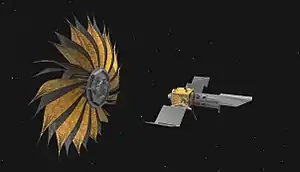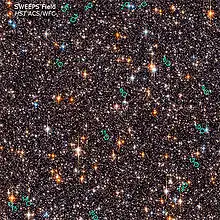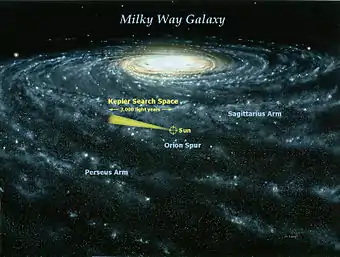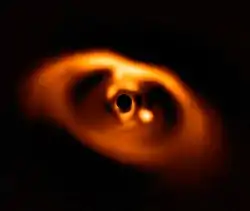Habitable Exoplanet Imaging Mission
The Habitable Exoplanet Imaging Mission (HabEx) is a space telescope concept that would be optimized to search for and image Earth-size habitable exoplanets in the habitable zones of their stars, where liquid water can exist. HabEx would aim to understand how common terrestrial worlds beyond the Solar System may be and the range of their characteristics. It would be an optical, UV and infrared telescope that would also use spectrographs to study planetary atmospheres and eclipse starlight with either an internal coronagraph or an external starshade.[3]
| Mission type | Space observatory |
|---|---|
| Operator | NASA |
| Website | www |
| Mission duration | 5 to 10 years (proposed) [1] |
| Spacecraft properties | |
| Launch mass | 18,550 kilograms (40,900 lb) (maximum) [1] |
| Dry mass | ≈10,160 kg (22,400 lb) |
| Payload mass | ≈6,080 kg (13,400 lb) (telescope + instruments) |
| Power | 6.9 kW (maximum) [1] |
| Start of mission | |
| Launch date | 2035 (proposed) |
| Rocket | Observatory: Space Launch System (SLS) Block 1B [1] Starshade: Falcon Heavy |
| Orbital parameters | |
| Regime | Lagrange point (Sun-Earth L2) |
| Main | |
| Diameter | 4 m (13 ft) |
| Wavelengths | Visible; possibly UV, NIR, IR (91 – 1000 nm) |
| Resolution | R ≥ 60,000; SNR ≥ 5 per resolution element on targets of AB ≥ 20 mag (GALEX FUV) in exposure times of ≤12 h [1] |
| Instruments | |
| VIS camera, UV spectrograph, coronagraph, starshade [1][2] | |
The proposal, first made in 2016, is for a Large strategic science missions NASA mission. If selected in 2021, it will operate at the Lagrange point L2.
Overview

In 2016, NASA began considering four different space telescopes as the next Flagship (Large strategic science missions).[3] They are the Habitable Exoplanet Imaging Mission (HabEx), Large Ultraviolet Optical Infrared Surveyor (LUVOIR), Origins Space Telescope, and Lynx X-ray Surveyor. In 2019, the four teams will turn their final reports over to the National Academy of Sciences, whose independent Decadal Survey committee advises NASA on which mission should take top priority. Selection is due to take place in 2021, and if selected, launch would be in approximately 2035.[3]
The Habitable Exoplanet Imaging Mission (HabEx) is a concept for a mission to directly image planetary systems around Sun-like stars.[4][5] HabEx will be sensitive to all types of planets; however its main goal is to directly image Earth-size rocky exoplanets, and characterize their atmospheric content. By measuring the spectra of these planets, HabEx will search for signatures of habitability such as water, and be sensitive to gases in the atmosphere potentially indicative of biological activity, such as oxygen or ozone.[5]
Science drivers and goals
HabEx's prime science goal is the discovery and characterization of Earth-sized planets in the habitable zones of nearby main sequence stars, it will also study the full range of exoplanets within the systems and also enable a wide range of general astrophysics science.
In particular, the mission will be designed to search for signs of habitability and biosignatures in the atmospheres of Earth-sized rocky planets located in the habitable zone of nearby solar type stars.[6] Absorption features from CH
4, H
2O, NH
3, and CO, and emission features from Na and K, are all within the wavelength range of anticipated HabEx observations.
With a contrast that is 1000 times better than that achievable with the Hubble Space Telescope,[6] HabEx could resolve large dust structures, tracing the gravitational effect of planets. By imaging several faint protoplanetary disks for the first time, HabEx will enable comparative studies of dust inventory and properties across a broad range of stellar classifications.[4] This will put the Solar System in perspective not only in terms of exoplanet populations, but also in terms of dust belt morphologies.[6]
General astronomy
General astrometry and astrophysics observations may be performed if justified by a high science return while still being compatible with top exoplanet science goals and preferred architecture. A wide variety of investigations are currently being considered for HabEx general astrophysics program. They range from studies of galaxy leakiness and inter-galactic medium reionization through measurements of the escape fraction of ionizing photons, to studies of the life cycle of baryons as they flow in and out of galaxies, to resolved stellar population studies, including the impact of massive stars and other local environment conditions on star formation rate and history.[6] More exotic applications include astrometric observations of local dwarf galaxies to help constrain the nature of dark matter, and precision measurement of the local value of the Hubble Constant.[6]
The following table summarizes the possible investigations currently suggested for HabEx general astrophysics:[6]
| Science driver | Observation | Wavelength |
|---|---|---|
| Local Hubble Constant | Image Cepheid in type Ia supernova host galaxies | Optical-NIS |
| Galaxy leakiness and reionization | UV imaging of galaxies (LyC photons escape fraction) | UV, preferably down to LyC at 91 nm |
| Cosmic baryon cycle | UV imaging and spectroscopy of absorption lines in background quasars | Imaging: down to 115 nm Spectroscopy: down to 91 nm |
| Massive stars/feedback | UV imaging and spectroscopy in the Milky Way and nearby galaxies | Imaging: 110–1000 nm Spectroscopy: 120–160 nm |
| Stellar archaeology | Resolved photometry of individual stars in nearby galaxies | Optical: 500–1000 nm |
| Dark matter | Photometry and astrometric proper motion of stars in local group dwarf galaxies | Optical: 500–1000 nm |
Preliminary desired specifications


Based on the science drivers and purpose, the researchers are considering direct imaging and spectroscopy of reflected starlight in the visible spectrum, with potential extensions to the UV and the near infrared parts of the spectrum. The telescope has a primary monolithic mirror that is 4 metres (13 ft) in diameter.
An absolute minimum continuous wavelength range is 0.4 to 1 μm, with possible short wavelength extensions down below 0.3 μm and near infrared extensions to 1.7 μm or even 2.5 μm, depending on the cost and complexity.[6]
For characterization of extraterrestrial atmospheres, going to longer wavelengths would require a 52 m (171 ft) starshade that would launch separately on a Falcon Heavy,[1] or a larger telescope in order to reduce the amount of background light. An alternative would be to keep the coronagraph small. Characterizing exoplanets at wavelengths shorter than ~350 nm would require a fully UV-sensitive high contrast optical train to preserve throughput, and will make all wavefront requirements more stringent, whether for a starshade or a coronagraph architecture.[6] Such high spatial resolution, high contrast observations would also open up unique capabilities for studying the formation and evolution of stars and galaxies.
Biosignatures
HabEx would search for potential biosignature gases in exoplanets' atmospheres, such as O
2 (0.69 and 0.76 μm) and its photolytic product ozone (O
3). On the long wavelength side, extending the observations to 1.7 μm would make it possible to search for strong additional water signatures (at 1.13 and 1.41 μm), and would also allow to search for evidence that the detected O
2 and O
3 gases were created by abiotic processes (e.g., by looking for features from CO
2, CO, O
4). A further infrared capability to ~2.5 μm would allow to search for secondary features such as methane (CH
4) that may be consistent with biological processes. Pushing even further in the UV may also allow distinction between a biotic, high-O2 atmosphere from an abiotic, CO
2-rich atmosphere based on the ozone absorption of 0.3 μm.[6]
Molecular oxygen (O
2) can be produced by geophysical processes, as well as a byproduct of photosynthesis by life forms, so although encouraging, O
2 is not a reliable biosignature, and it should be considered in its environmental context.[7][8][9][10]
References
- HabEx Final Report. The Habitable Exoplanet Observatory Study Team. JPL/NASA. 29 August 2019
 This article incorporates text from this source, which is in the public domain.
This article incorporates text from this source, which is in the public domain. - HabEx Instruments Suite. NASA JPL. Accessed on 11 December 2019
 This article incorporates text from this source, which is in the public domain.
This article incorporates text from this source, which is in the public domain. - Scoles, Sarah (30 March 2016). "NASA Considers Its Next Flagship Space Telescope". Scientific American. Retrieved 15 October 2017.
- Mennesson, Bertrand (6 January 2016). "The Habitable Exoplanet (HabEx) Imaging Mission Study" (PDF). JPL (NASA). Retrieved 15 October 2017.
 This article incorporates text from this source, which is in the public domain.
This article incorporates text from this source, which is in the public domain. - Seager, Sara; Gaudi, Scott; Mennesson, Bertrand. "Habitable Exoplanet Imaging Mission (HabEx)". Jet Propulsion Laboratory. NASA. Retrieved 15 October 2017.
 This article incorporates text from this source, which is in the public domain.
This article incorporates text from this source, which is in the public domain. - Mennesson, Bertrand; Gaudi, Scott; Seager, Sara; Cahoy, Kerri; Domagal-Goldman, Shawn; et al. (24 August 2016). MacEwen, Howard A.; et al. (eds.). The Habitable Exoplanet (HabEx) Imaging Mission: preliminary science drivers and technical requirements (PDF). SPIE. doi:10.1117/12.2240457.
- Léger, Alain (2004). "A New Family of Planets ? "Ocean Planets"". Icarus. 169 (2): 499–504. arXiv:astro-ph/0308324. Bibcode:2004Icar..169..499L. doi:10.1016/j.icarus.2004.01.001.
- Extreme Water Loss and Abiotic O2 Buildup on Planets Throughout the Habitable Zones of M Dwarfs. Luger R. and Barnes R. Astrobiology. 14 February 2015, Vol 15, Issue 2; pages 119–143. DOI: 10.1089/ast.2014.1231
- Titania may produce abiotic oxygen atmospheres on habitable exoplanets. Norio Narita, Takafumi Enomoto, Shigeyuki Masaoka, and Nobuhiko Kusakabe. Scientific Reports 5, Article number: 13977 (2015); doi:10.1038/srep13977
- Seager, Sara (2013). "Exoplanet Habitability". Science. 340 (577): 577–581. Bibcode:2013Sci...340..577S. doi:10.1126/science.1232226. PMID 23641111. S2CID 206546351.


